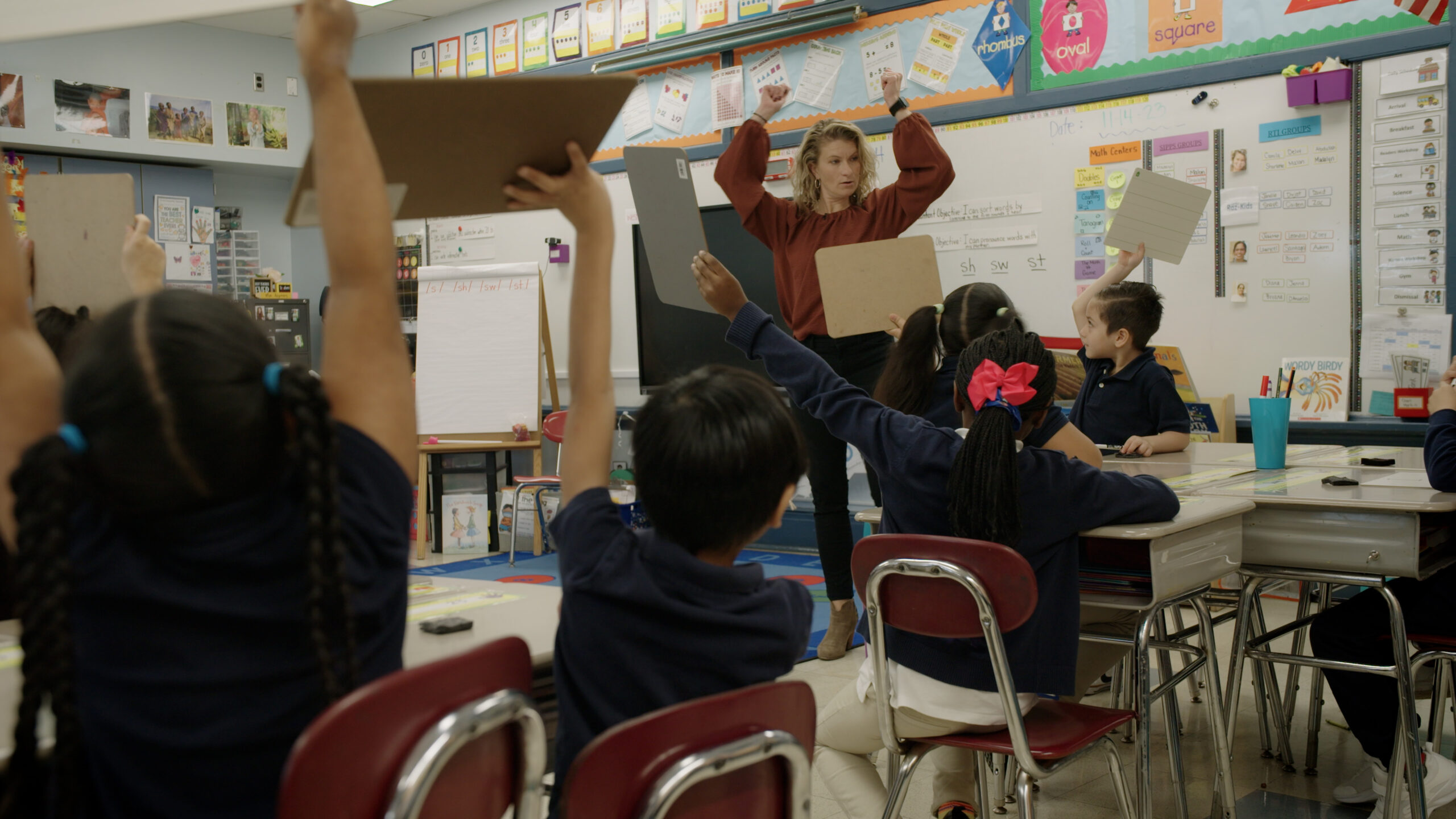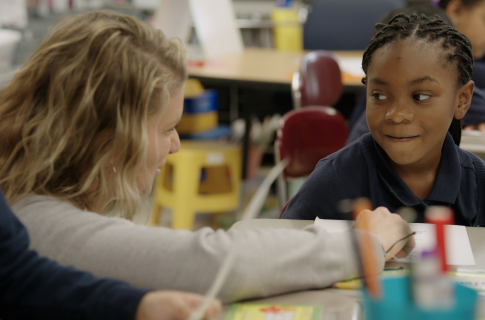Read Like You Talk
Overview
The teacher models make meaning and identify with characters through tone using portions of dialogue from a familiar text. The teacher and students discover the emotion behind the character’s dialogue and identify keywords and punctuation that provide clues to read with prosody.
Key Take-aways
• Consider practicing this activity using theater or role-playing.
• Provide ample opportunities for modeling and echo-reading to support fluency.
• Focus on decoding skills and accuracy to support fluency development.
Transcript
Dr. Ken Kunz: In the whole group area, students read with specific tones, bringing dialogue from our story to life. Guided by the teacher’s examples, they infuse fluency and expression, matching the text tone. Our teacher showcases how tone connects us to characters and fuels meaning using playful variations in intonation,
Teacher: First-grade readers know how to read like you talk. Take a look at our little emoji. What does it look like? Happy is happy. So we can read when we’re reading stories or passages, we can read with a happy tone.
Student(s): Yay.
Teacher: Listen to how I read it and I want you to tell me thumbs up or thumbs down if I’m reading with a happy tone or not. Okay? Maya smiled brightly and said, hi, I’m Maya. It’s nice to meet you all. Thumbs up or thumbs down? Was I reading a happy tone?
Student(s): Yes.
Teacher: Yes. Are there any words, clue words, in this sentence that tell you to read in a happy tone? Jenna?
Student(s): Smiled brightly.
Teacher: Smiled brightly. Right? Very good. Anything else? Juliet?
Student(s): Hi.
Teacher: You could say hi. Yeah. You’re being happy and, and nice, right? Are there any kind of, we talked about this. Are there any kind of punctuations?
Student(s): Yes.
Teacher: That we can see…
Student(s): Yes
Teacher: ..that makes us read in happy tone?
Student(s): The exclamation mark.
Teacher: The exclamation mark, too, tells you. Hi, I’m Maya! You change your voice when you read that, right? All right. So when we’re going through all of these, let’s look for some clue words to tell us how we’re supposed to be reading the, the sentences. Okay.
Student(s): Sad.
Teacher: Aw. Sad tone. Can you all tell me and can I hear how we talk in a sad tone? Let’s say, say it for me.
Student(s): Sad tone.
Teacher: And look at all your faces look so sad too, right? Maya? Sadly mentioned. I wish I had more friends here. Let’s take a look. Any clue words? Any clue words? Laruso.
Student(s): Sad.
Student(s): Maya sad. Sadly.
Teacher: Sadly, right? That tells you right there that we should be talking like we’re sad. Okay. Any other ones? I think that’s it, right?
Student(s): No. One more. More.
Teacher: More what?
Student(s): More friends.
Teacher: More friends. Does that tell you that she’s sad because she has no friends and she wants more? Do you know what this one is?
Student(s): Really sad.
Teacher: Close. All right, so this one’s a regretful tone.
Student(s): Regretful.
Teacher: Do you know what regretful means? Remember, let’s go back to the story. Do remember at the very end? She was very regretful because she was not kind to the new girl. Regrets.
Student(s): She feels bad.
Teacher: She feels bad that she never got a chance to be her friend. Okay, so we are going to read this in a regretful tone. All right, what do we think? Let’s take a look at our emoji. We go over this all the time. We talk about it every morning. What does kind mean?
Student(s): To be nice.
Teacher: To be nice, right? So, how would we read this sentence in a kind tone? Remember, kind tone.
Student(s): Chloe said, Maya, we want to be your friends. Let’s play together.
Teacher: Very good. Do you think he read it in a kind voice?
Student(s): Yes.
Teacher: Yes. All right. Ooh, do you know what that word is?
Student(s): Guilty
Teacher: Let’s read it. Guilty tone. Think about it. I want you to turn and talk to your partner. What do you think guilty means?
Teacher: Brianna?
Student(s): Its when you do something, or you say something mean. You feel bad, and you wish you didn’t.
Teacher: Yeah, you feel bad. You feel guilty for doing something that you shouldn’t have done. Right? So it’s kind of like you feel bad, you feel sad. You’re kind of embarrassed that you did something you shouldn’t have done. So this is how we read when we’re reading passages: we look for clues in our sentences and in our stories that tell us how we’re supposed to be reading the sentence. And that makes us a super fluent reader. Okay.
Dr. Ken Kunz: In this video, you witnessed an opportunity for students to read like they talk, choosing different tones. Students are able to practice with dialogue from a familiar story. A social and emotional learning perspective connects tone and characters’ feelings to examples from the text. This demonstrates how all literacy learning can be social and emotional.


